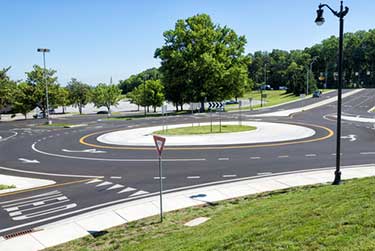
Written by Kayla Jane Barrie Updated on Mar 03, 2025 6 mins read

Have you noticed more roundabouts popping up in your city? They’ve become a popular road feature to reduce accidents. Not sure about roundabout rules? Need to freshen up on your knowledge about how to drive in roundabouts? Take some time to familiarize yourself with these tips for driving through roundabouts in Ontario.
Roundabouts are circular intersections where two or more roads meet. Traffic circulates through roundabouts counter-clockwise around a central island. Roundabouts are designed to make intersections more efficient and safer for drivers, cyclists and pedestrians.
Municipalities are choosing roundabouts over traditional stoplights because they are less expensive to operate (no installation and maintenance of signal lights) and cost less to pave. Roundabouts can have anywhere from one to several lanes, depending on how much traffic circulates in the area.
Most importantly, studies show that roundabouts have fewer conflict points, which can lower the chances for serious accidents. They prevent costly accidents and injuries, which should help with lower car insurance in Ontario.
When you approach a roundabout, here is what you should do :
A traffic circle is much larger than a roundabout. With traffic circles, each entry and exit point becomes a T-intersection that can require a full stop at a set of lights. Instead of a T-intersection, roundabouts have merge lanes that require you to yield to traffic and enter once it is safe.
Once you have decided what exit to take, here are some tips on which lane to drive in.
Roundabouts are safer than traditional stoplight intersections. Studies show that there are approximately 32 conflict points at an intersection versus eight in a roundabout. The study in 2000 found that roundabouts reduced the number of collisions by 35%, lowered the number of injuries by 76%, and fatalities by 90%.
The chance of serious injury decreases with roundabouts. Since cars are driving slower, drivers have more time to react. When accidents do happen, they are minor compared to traffic light intersections.
The central island is designed to prevent drivers from seeing the headlights of oncoming vehicles at night. It also gives drivers an indication that there is an obstruction in the roadway and that they can’t drive straight through.
Feel confident the next time you approach a roundabout with these tips.
If you are driving in a roundabout and an emergency vehicle approaches, exit at your intended exit and proceed beyond the traffic island before pulling over. If you haven’t entered the roundabout, pull over to the right and wait until the emergency vehicle has passed before entering.
Yes. Pedestrians should wait for a gap in traffic before crossing. Never walk through a roundabout or the central island.
Cyclists can dismount and walk their bikes through the crosswalks, similar to pedestrians. If you are an experienced cyclist, you can merge into the vehicle lane and exit when your exit lane appears. As a driver, it is your duty to yield to pedestrians and cyclists at a roundabout to prevent an accident, which can impact your car insurance quotes.
Roundabouts are similar to intersections. You should always signal in the direction you plan on taking. Here are some directional tips for signalling in a roundabout.
 Roundabout ahead, be alert and slow down.
Roundabout ahead, be alert and slow down.
 When driving toward a roundabout, yield to all traffic and pedestrians. This is a reminder that you may have to stop.
When driving toward a roundabout, yield to all traffic and pedestrians. This is a reminder that you may have to stop.
 Keep to the right.
Keep to the right.
 There are two entry lanes to the roundabout. Choose the appropriate lane for your destination.
There are two entry lanes to the roundabout. Choose the appropriate lane for your destination.
 Intersections for the roundabout. This sign will help you choose your exit.
Intersections for the roundabout. This sign will help you choose your exit.
 Each exit will have a sign. Signal when you are leaving the roundabout.
Each exit will have a sign. Signal when you are leaving the roundabout.
 Traffic only flows in one direction (counter-clockwise) in a roundabout.
Traffic only flows in one direction (counter-clockwise) in a roundabout.
 The right lane will end. Be mindful of merging traffic.
The right lane will end. Be mindful of merging traffic.
On a greener note, roundabouts have a positive impact on the environment. They cut vehicle emissions and fuel consumption because there is less idling at intersections. Vehicles slowly drive through roundabouts, which minimizes the highway feeling of roads in suburban and urban areas. There is also an opportunity for municipalities to landscape the central island.
Are you seeing more roundabouts in your municipality? Check out these common questions about roundabouts.
Drivers and cyclists who are already using the roundabout have the right-of-way. Vehicles entering the roundabout must always yield and wait for a safe gap to enter.
Common roundabout collisions include :
You should always signal when you are going to exit the roundabout. Here's how to do it correctly :
If you miss your exit while driving through a roundabout, you can circle one more time. Continuously driving around the roundabout more than twice can be considered careless driving. If you are lost, make a safe exit and pull over when it’s safe to find your bearings.
Roundabouts are safer than traditional intersections. Lower speeds and fewer points of conflict lower the number of serious accidents. Roundabouts allow for a higher volume of traffic to flow through, which helps lower the amount of stops and delays. Cars will idle less in roundabouts, reducing fuel consumption and improving air quality.
Reducing your speed as you approach a roundabout will give you time to read the sign and choose the correct lane. Look for signs and road markings to help decide what exit and lane to take. Never change lanes in a roundabout.
The amount of traffic and travel speed determines the size of a roundabout. They need to be large enough for buses and large trucks but also small enough that drivers need to slow down to go around them.
A cyclist can dismount their bike and cross when there is space at the crosswalk. Experienced cyclists can ride through as if they were driving a car. You can merge into the lane before the bike lane ends. Ride in the centre of your lane, not hugging the curb. Use hand signals when you are exiting. Never cross the central island of a roundabout.
Accidents can still happen, even when you drive carefully and follow the rules. Always take time to familiarize yourself with driving tips in your municipality.
| Categories | Auto |
|---|---|
| Tags | Driving Tips |
Read our insurance blog to get helpful tips, information and news.
What is specified perils insurance coverage? Learn about named perils policies for Ontario drivers. Get info about coverage, if you need it & answers to common questions.
What is all perils insurance? We’ll answer your questions about all perils insurance in Ontario. Learn about what it covers and if you need it.
Are you aware of how speeding tickets affect your car insurance? Here, we outline how speeding tickets can impact your policy.
Thinking of filing a car insurance claim? Want to learn more about the process? Get tips and answers to common questions about auto claims.